That's a question I get quite frequently. So here is the answer in hopes you wont ask me that question for the 400th time. LOL
Traditional sandblasting is a large DRY air stream pushing a small amount of abrasive through a hose. When the dry air and abrasive come out of the hose, it chews off rust, paint or some other coating you want removed off the surface.
Dustless blasting is the same except we are not using dry air to push the abrasive out of the hose. We are using WET air, WET abrasive. Not liquid but moist and sticky and maybe misty.
What is the difference between dustless blasting and traditional sandblasting?
As the abrasive chews the paint or rust off the surface, it does so in very small particles. Small particles can float in the air for a little while before falling to the ground. These small floating particles are known as dust.
Also in a professional rig like ours, the abrasive is coming out of the hose at about 420 MPH. As the abrasive grain smashes against the surface removing paint/rust, the grain smashes into smaller pieces like a breaking bottle.
The smaller of these pieces when tiny enough, also float as dust. Not often, but sometimes that dust becomes inconvenient.
When we are blasting metal, the dust is minimal although it does exist to some extent. It does not float long before it falls to the ground. And it normally will not float very far away.
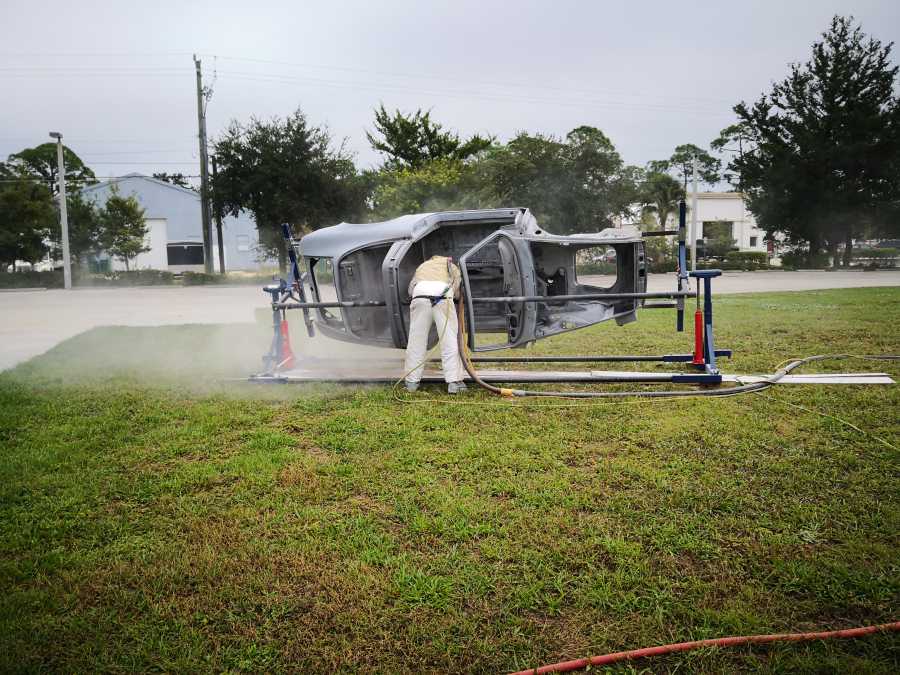
If I'm blasting in a wide open yard, the dust does not bother us. If I'm blasting in a garage the dust will build up faster than it is falling to the ground, and then the dust strongly inhibits our ability to see clearly what we are working on.
That can be a nuisance. I do try to avoid blasting in small enclosed spaces when possible. But most of the time, the small amount of dust is not a deal breaker. However there is one exception.
Blasting concrete, cement, brick or stone. After the fast flying abrasive grain chips off a piece of paint off the concrete, it goes a little further and chips off a small piece off the concrete itself.
If the piece of concrete chipped off is small enough, it will also float as dust for a while. So when we are blasting concrete, cement, brick or stone, the blasting process makes significantly more dust than when we are blasting metal.
BELOW: We are dry sandblasting the paint off a brick floor inside a house. The dust certainly did accumulate faster than it fell to the floor and visibility became challenging.
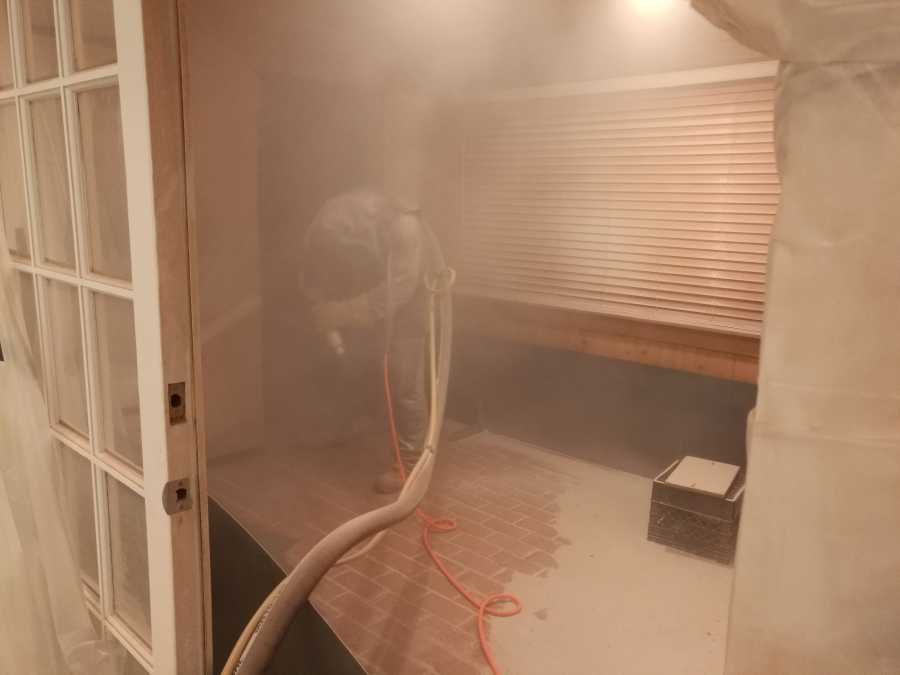
Below you can see the paint that's been removed verses what's waiting its turn to be blasted away.
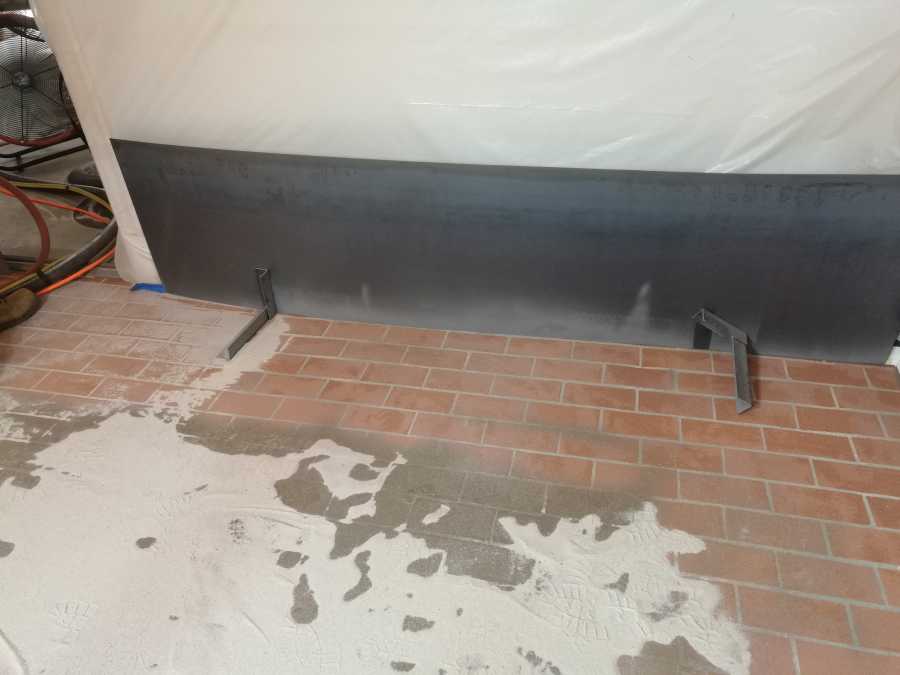
BELOW: You can see three strong industrial fans pumping fresh air into the room to purge the dust out the back door. In the front, out the back.
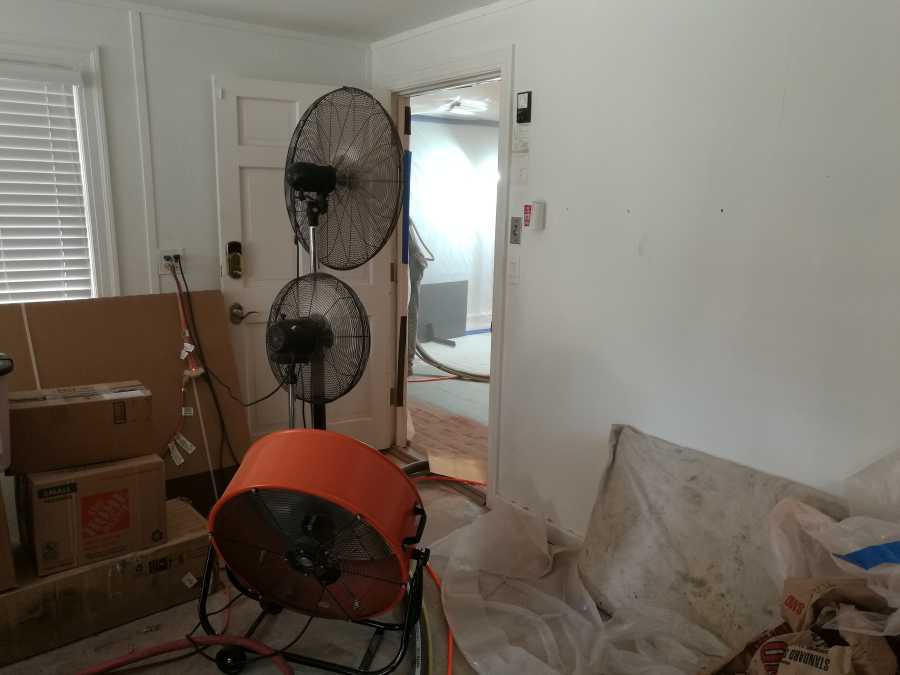
We did not want to wet blast these rooms as the moisture would have stained the walls in a bad way. And then the clean up would not have been easy to sweep, lightweight dry sand that can be scooped up, it then would have been heavy, hard to handle mud.
Then what do you do with it? You cant sprinkle mud across your grass and make it disappear. But the potential for wall damage from moisture made dustless blasting here not an option.
BELOW: With the large continuous purge of air, the dust in the room was kept manageable and visibility could be maintained.
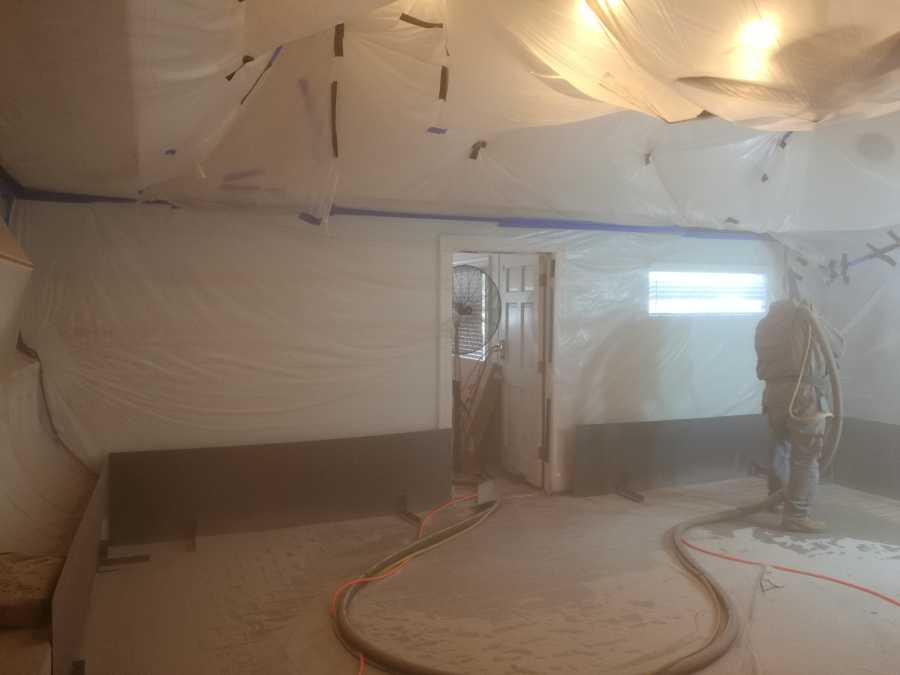
Blasting brick, concrete, stone or cement creates more dust than blasting metal.
Usually the extra dust generated is merely a slight inconvenience and not a major problem. However we can reduce the dust generated by 95-99% by adding a very small amount of water into the air flow of our blast hose.
While the air coming out of our blast hose contains a small mist of water, and the abrasive grain coming out of our blast hose is wet, the small pieces chewed up become wet themselves and this makes them significantly heavier so they quickly fall to the ground and don't float.
BELOW: We are wet blasting the paint off a concrete driveway. Since it is wet sand blasting, it is dustless sandblasting. Here the moisture from the sandblasting is totally acceptable. Rust is not an issue. And the wet sand will be washed out into the grass so it disappears under the grass to be joined with our Florida's sandy terrain.
In some situations dustless blasting is very beneficial.
The heavy wet dust quickly falls to the ground and does not float in the air. So now we've reduced the dust generated. Sound great doesn't it?
Well sometimes it is pretty good. But sometimes its not good at all.
What's the problem with dustless blasting? What's the problem with wet blasting?
Sometimes none, but sometimes its a huge problem. Traditional blasting is dry blasting. Dustless blasting is wet blasting.
Now you have the spent abrasive media laying on the ground. If it is dry abrasive its very easy to clean up. If it is wet abrasive, it is mud, and mud frequently is a huge nuisance to clean up. If it is dry it is lightweight. If it is wet, it is twice as heavy.
More than 50% of the time when we are blasting concrete, brick or stone, we will wet blast it. The wet abrasive can then be washed off the driveway with a normal garden hose and washed into the grass.
The same blasted driveway is easier cleaned when the abrasive is dry. 400% easier. Any leaf blower will easily blow the sand or abrasive off the driveway, and with diligence, will blow it further out into the yard so you don't have a sand build up at the edge off the grass touching the driveway.
This sidewalk was dry blasted for ease of blowing the spent sand off the sidewalk and out into the grass for clean up.
Above: Before blasting sidewalk for paint removal.
Below: After DRY blasting sidewalk and blowing spent sand out into the grass to disappear. We were able to blow the sand 5-10 feet further past the edge of the sidewalk so it mostly blended in and disappeared.
This sand falls below the grass and mostly disappears. Each future rain will make the light colored sand disappear more as it floats the darker organic matter to the surface and above the sand.
You can speed up the blending process/sand sinking with a garden hose if you have a hour or two to spend. Also the grass growing process automatically elevates the grass above the dirt/sand without human intervention. But that takes a month or two. But it is free and effortless.
The sand that landed in the mulch bed, no problem. Some of the mulch will be scooped up and thrown out. Some but not all. Then it will be rinsed with a garden hose to move the sand off of and to below the existing mulch left behind. Then some new mulch will be spread down and all is perfect again. No more visible sand.
But when we dustless blast, the wet abrasive will not wash out into the yard as far as the dry abrasive will blow. So if it was blasted wet, when you wash the abrasive off the driveway and out into the grass, you can see some sand build up closer to the driveway.
BELOW: First of all this is a driveway and not a sidewalk so realize much more abrasive was needed, and then left behind when spent.
(Red Arrows) We started at the street and blasted up the driveway to keep the abrasive out of the street.
You can see the build up of sand moving ahead of us. Now its too thick to keep moving ahead of us. Now we must push it to the grass. But since its wet and heavy, it will not go very far into the grass and will build up much more, close to the driveways edge.
The wet abrasive is a taller build up and sometimes taller than the grass closest to the driveway. So it takes more effort to rinse it away and spread it out further. In a month or two, the grass will grow onto and above the sand and it disappears eventually.
But it would have dispersed much further and thinner if it was dry and not wet.
So we are always balancing and evaluating which is the larger inconvenience, the dust or the clean up.
Most of the time the dust is the easiest to deal with. It does not float for very long (10-15 seconds) and it does not float very far. The dust will not normally leave the yard we are working in.
And whatever the dust does land on, nearby bushes etc... can easily and quickly be rinsed off with a garden hose and the dust is now gone.
But if we are blasting the paint off a brick building downtown, we would probably wet blast it. If we were blasting the paint off the brick on your garage in a normal sized yard, we would probably dry blast it.
If we are blasting metal we nearly always dry blast it. You don't want wet abrasive/mud packed into the nooks, corners, cranny's and holes of your automobile because you nearly cannot get it out later.
Here is a rotisserie holding a 1972 Porsche.
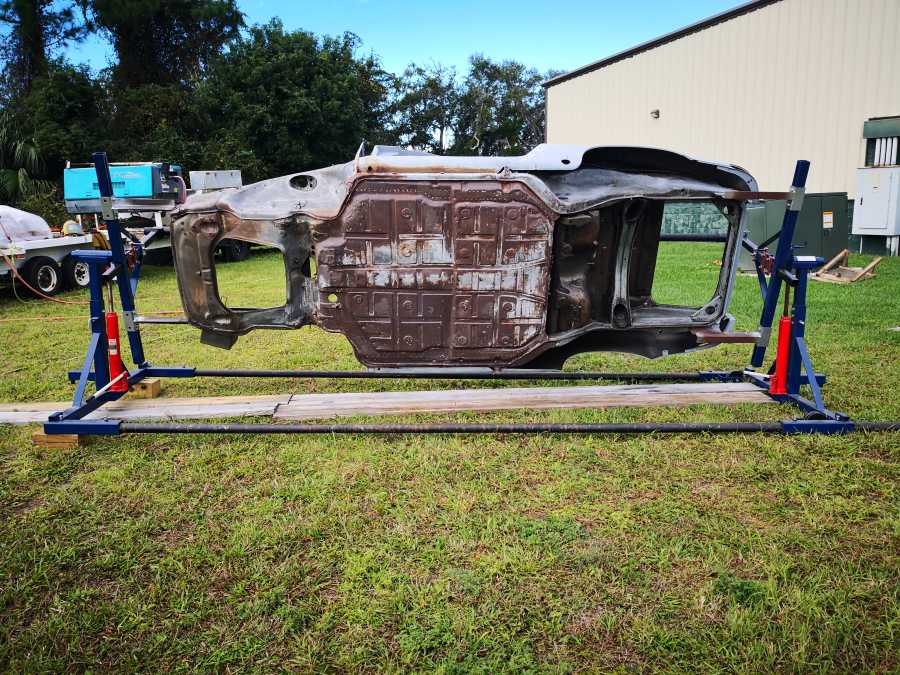


You can see we do generate some dust.
But now look at all the nooks, cranny's, corners and hole that do get filled up with abrasive when sand blasting.
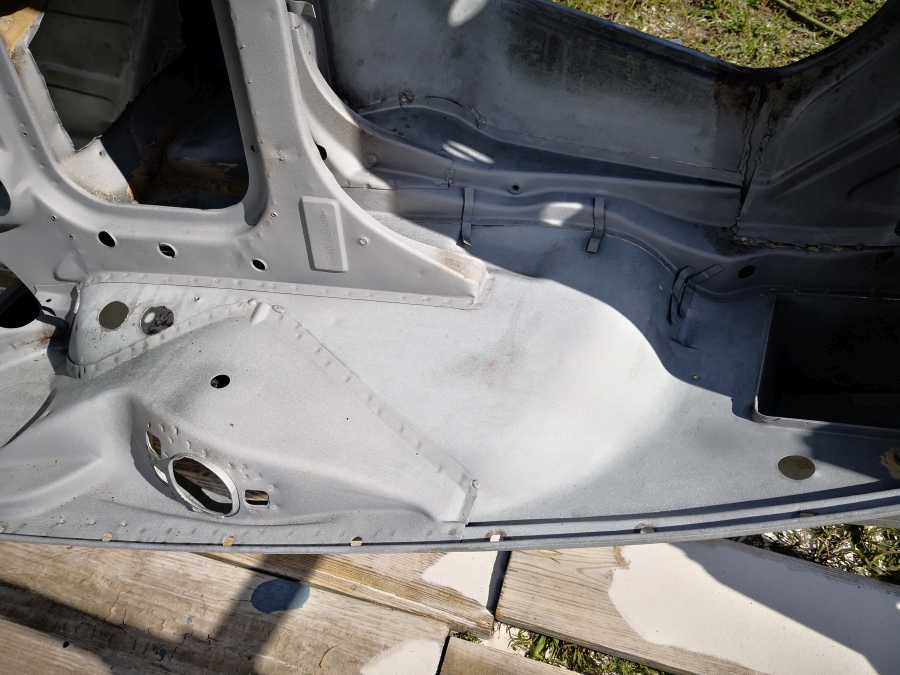
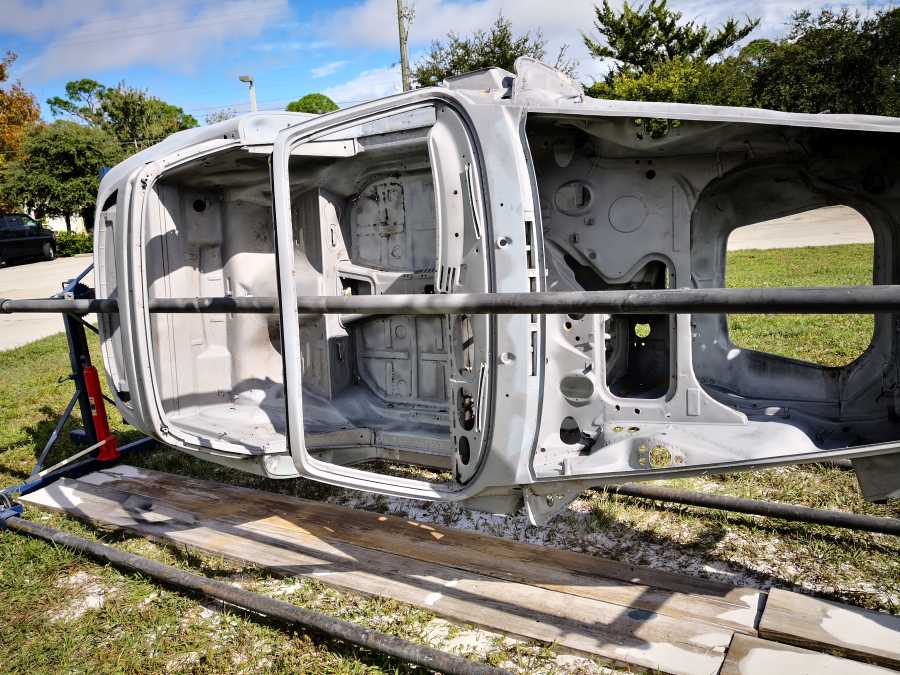
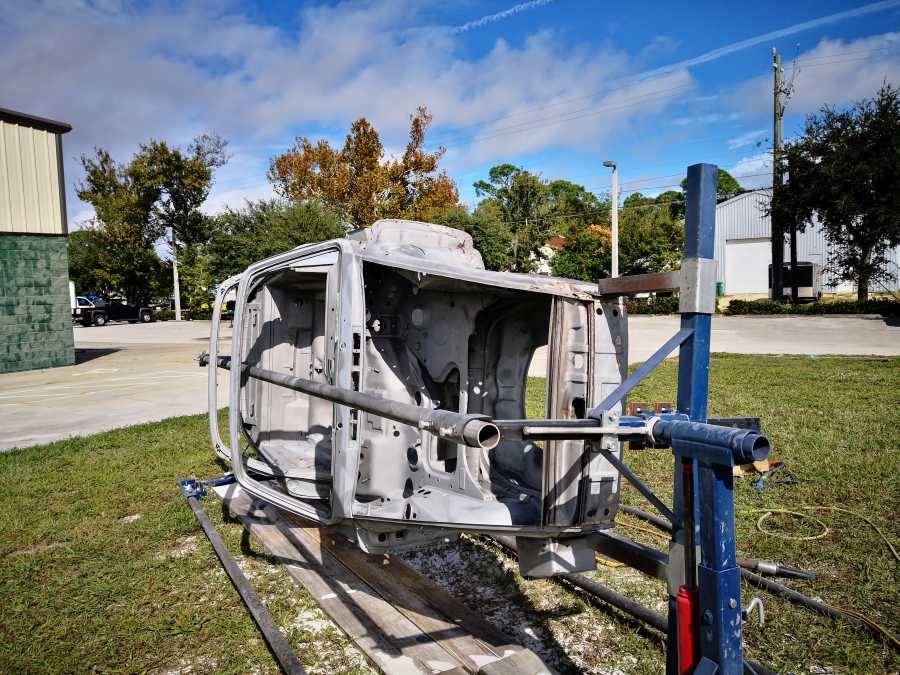
Click the play button on the video below.
Since its dry abrasive, it just falls out and is easy to blow out the rest.
Now look at the wet spent abrasive below, its wet sticky mud. Can you imagine it filling up and packing in all the corners, nooks, cranny's and holes in the body of the Porsche?
Dry abrasive however is very easy for us to get it out of the holes with our air hose. When we blast a vehicle, we always blow the dry abrasive off and out of the vehicle completely before we leave.
Why?
Because we have a giant air compressor, giant air hoses and its already there and set up. Its a piece of cake for us to blow all the spent abrasive out of and off of your vehicle before we leave.
It would be much harder for you to blow it clean yourself.
But if you have us dustless blast your vehicle, its packed with mud, we wont clean it, its all on you, and you will regret it later.
Now I need to pop a myth, a common misconception called DUSTLESS BLASTING.
I do dry blasting and I do wet blasting. I have a special rig that can do both. I will do whatever you want. There is NO price difference for wet or dry blasting. I have nothing to gain by doing it wet or dry. I have nothing to gain by lying to you.
However there is a company and their brand name is DUSTLESS BLASTING. They manufacture blasting pots which will only shoot wet. Their pots cannot shoot dry. As every manufacture out there, they want to make their system sound like it is the best.
The DUSTLESS BLASTING brand has made hundreds of videos and flooded YouTube. In an effort to promote their brand, they push the misconception that wet blasting is great for everything and it is the best.
They do this in an effort to get people to buy their brand of blasting pot instead of another brand of blasting pot. A few of their claims are true and many of them are not.
Here's the problem.
The video campaign was very effective and because their systems are very inexpensive, they have literally sold thousands of them nationwide.
There must be a lot of gullible people out there because they have sold a lot of those inferior units.
Newbie's just getting into the abrasive blasting business nearly always buy the Dustless Brand Blaster because it is so much less money and they just don't know any better yet.
The inexperienced really believe wet blasting is great for everything, or their willing to lie about it and claim it to be so.
Now a lot of wanna be contractors own a Dustless Blasting rig and they need work to do with it so they can pay for it and hopefully make a living off of it.
However in their effort to promote their business, they nearly all tend to overstate the value and abilities of wet blasting. And since wet blasting is all they can do, its understandable why they do although it doesn't make it right.
Can you imagine a guy that does wet blasting saying, "you would be better off having this blasted dry although I cant blast it dry for you"?
One of the problems with wet blasting steel is the moist nature of it promotes immediate rust, called flash rust. We can add a chemical to the wet blast process that stops rust for about 72 hours so flash rust is not a problem.
All the guys that own a Dustless Brand Blasting rig state that "Hold Tight 101" does a perfect job of preventing the wet blast process from immediately beginning to rust.
Well that's true.
But what they don't tell you is the real problem.
You've just wet blasted it, blasted it with mud. Wet sand is mud in case you were not aware. It looks clean but has a slimy layer of wet dust = mud, wet small dusty grit stuck to it.
No painter I've ever met will paint over it without cleaning it first. But washing removes the Hold Tight 101 and that will allow it to flash rust.
If you've just had it blasted to remove rust, surely you don't want to allow rust to begin and then paint over the beginning rust.
That kind of defeats the purpose, doesn't it? But Dustless Blasting guys say its ok to paint over it without washing off the Hold Tight 101, without washing off the thin mud/wet dust layer still binding to the raw naked metal.
If you believe them and paint it the way it is, you now have a dirt layer, although thin and nearly not visible, between the paint and metal.
In case you did not know it, I'll inform you paint does not stick very well to dirt, dust, slime or mud.
Imagine sprinkling flour over the surface of a table and then spray painting it. Much of the paint is touching the flour and not the table and that part of the paint does not want to adhere long term.
BE WARNED: Painting after dustless blasting has real issues with long term adhesion.
You could wet wash the auto and remove the thin mud layer, but also remove the chemical Hold Tight 101 and allow instant rust to begin. But if your going to do that, then don't even bother with the Hold Tight 101 and just wet wash the car when your done blasting it and let flash rust begin.
OR
Dry blast it to start with and your not smearing the car with nearly invisible wet mud. Now your not packing thick mud in every nook, cranny, corner and hole.
Now the dry abrasive easily and quickly blows out of those holes. Now you have bare dry metal ready for painting.
And dry blasting costs the same as wet blasting. Which would you rather deal with, a little dust for a little while, or paint coming off the car 1 or 2 years later?
If you meet a guy that owns a Dustless Blaster Brand and he claims you can paint your auto directly after the car dries, and on top of the Hold Tight 101.
Then ask him what will happen if you wipe that car after he is done while it is still wet, with a clean white dry towel?
And really do it. Test it. When your looking at all that brown smudge that magically showed up on the white towel, ask yourself this question.
Do I really want this mud/smudge between my paint job and the car?
However when we are blasting fibreglass sailboats in a marina, dustless wet blasting is a huge bonus. In a Marina it is common there are other people working on their boats at the same time.
At any one given point in time, the chance is reasonable that someone else is applying varnish, stain or paint to their boat and at that point, even a small amount of dust can mess up the job they are doing.
Now is one of the most beneficial times for wet blasting because it catches the dust and stops it from traveling. A rust issue does not exist on a fiberglass boat. There is nothing to loose by washing the boat after blasting it for removing the mud slime before painting it. Here is where wet blasting really shines. Its all gains and no losses.
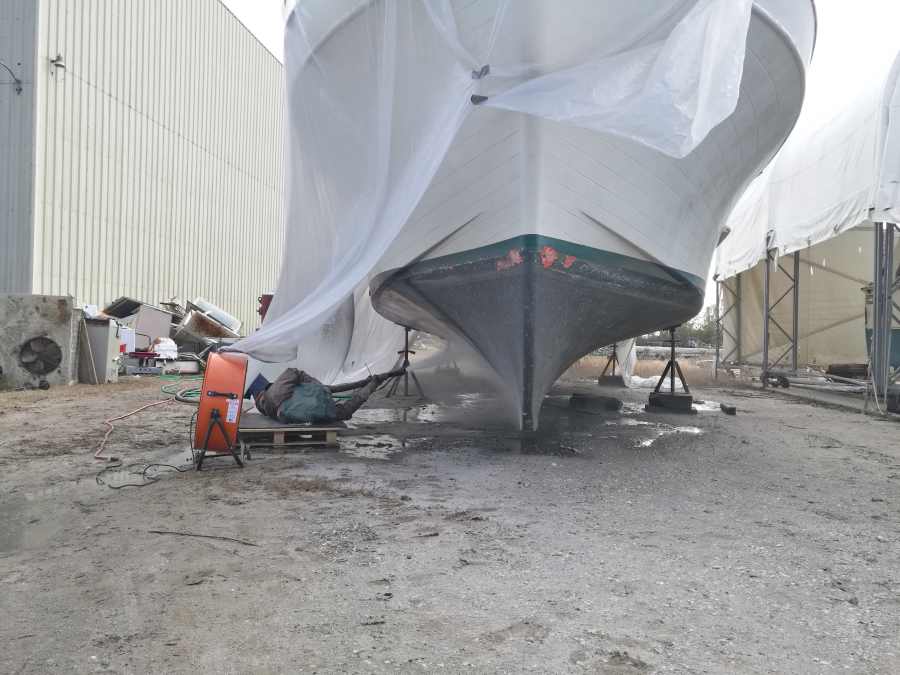
This marina was in Georgia. This 44' yacht was wet blasted, Dustless blasted. You can see the water mist being blown at the boat along with the abrasive.
Our water mist flow was turned up higher than needed for dust suppression, but that's harmless.








